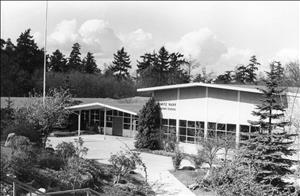This People's History of Schmitz Park Elementary School is taken from Building for Learning: Seattle Public School Histories, 1862-2000 by Nile Thompson and Carolyn J. Marr. That book, published in 2002 by Seattle Public Schools, compiled profiles of all the public school buildings that had been used by the school district since its formation around 1862. The profiles from the book are being made available as People's Histories on HistoryLink.org courtesy of Seattle Public Schools. It should be noted that these essays are from 2000. Some of the buildings profiled are historic, some of recent vintage, and many no longer exist (new names and buildings not included in these profiles from 2000 have been added), but each plays or has played an important role in the education of Seattle's youth.
Schmitz Park Elementary School
The only virgin forest in any Western Washington city lies in a park above Alki in West Seattle. Former Seattle Parks Commissioner Ferdinand Schmitz and his wife Emma donated 38 acres to the city in 1908 and 1912. Another 7.5 acres were purchased by the city from the Alki Street Car Line. The resulting site, named Schmitz Park, is considered to be one of the most beautiful natural parks in a U.S. urban area. One of the Schmitz's sons, Dietrich, served on the Seattle School Board from 1928-61 and was its president eight times, making him the longest serving board member.
The first Schmitz Park School was an all-portable facility developed in the early 1950s to relieve crowding at Genesee Hill and Lafayette. More portables were added annually from 1954 to 1956 until there was an office, 10 classroom portables, a double-portable lunchroom, and a utility portable. Starting with K-3, the highest grade was retained until it became a K-6 facility in its fourth year of operation.
A permanent single-story building of fire-resistant materials and laminated beams was erected on the enlarged site in 1962. Enrollment the first year was 380, the largest student body in the school's history.
Since the mid-1970s, a highlight of the annual fall opening of the school is the flag-raising ceremony, in which members of the Schmitz family participate, most recently Alan Schmitz.
Under the district's desegregation plan, Schmitz Park served as a K-3 facility from 1978-1988, forming a triad with Genesee Hill (K-3) and Beacon Hill (K, 4-6). In September 1979, parents voiced their disapproval of a district proposal that would have eliminated the regular school program at Schmitz Park. Instead, they suggested that Schmitz Park be enlarged and nearby Genesee Hill closed. Schmitz Park remained open and Genesee Hill was closed in 1989, then later reopened as an alternative school site.
Schmitz Park students received the President's Challenge Physical Fitness Award in 1998 and 1999, and their instructor, Barbara McEwan, was named state PE teacher of the year. Unique programs in bicycle safety and water safety are offered.
Throughout the school's history, the adjacent park has provided an outdoor classroom for nature studies, science, and conservation. The school's mascot, The Red Fox, was inspired by a real fox family that visits the playground each fall and spring and inhabits the nearby woods.
Details:
Name: Schmitz Park School
Location: 50th Avenue SW & W Hinds Street
Building: Portables
Site: 3.5 acres
1953: Opened September 21 as annex to Genesee Hill
1954: Officially named on April 16
1956: Became independent school
1960: Site increased to 7 acres
1962: Closed in June
Name: Schmitz Park Elementary School
Location: 5000 SW Spokane Street
Building: 12-room
Architect: Durham, Anderson & Freed
Site: 7.6 acres
1962: Opened in September
Schmitz Park Elementary School in 2000
Enrollment: 341
Address: 5000 SW Spokane Street
Nickname: The Red Fox
Configuration: K-5
Colors: Green and gold
Motto: "Smart as a fox"
Seattle Public Schools, 1862-2000: Schmitz Park Elementary School
- Posted 9/12/2013
- HistoryLink.org Essay 10589
Sources:
Nile Thompson and Carolyn J. Marr, Building for Learning: Seattle Public School Histories, 1862-2000 (Seattle: Seattle Public Schools, 2002).
Licensing: This essay is licensed under a Creative Commons license that encourages reproduction with attribution. Credit should be given to both HistoryLink.org and to the author, and sources must be included with any reproduction. Click the icon for more info. Please note that this Creative Commons license applies to text only, and not to images. For more information regarding individual photos or images, please contact the source noted in the image credit.

